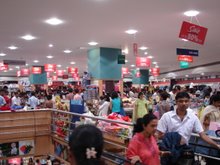Cloak-and-dagger stuff in Indian Retail rivalry
THE next time you visit your neighbourhood kirana for your vegetables, keep an eye open for the ‘phantom visitor’. He will, in all likelihood, pretend to be interested in buying goods, but all he wants to do is to check out the prices. This ‘price spy’ will keep a track of the prices of more than 30 typical items sold at a grocery store. He knows the daily changes in prices of virtually all essential commodities — rice, dals, oils, sugar and a few other typical high consumption goods that go into the consumer’s basket. You can find him surreptitiously scouring the wholesale market, the self-service format and most importantly, rival retail chains. Often, he has a budget to buy certain goods just so that it doesn’t appear like he’s hanging around to spy on the competition. Once he is armed with the prices of oils, rice, dals and other commodities, he reports back to his operations team and they then determine the future prices and offers for their store. As the battle for the fickle consumer’s shopping basket becomes fierce, knowing the deal that competition is offering can be the difference between being an investor’s delight or a distressed asset. Says S Raghunandan, formerly CEO, Hypercity, and an independent retail consultant, “Every retail chain would have people who scout around for prices and offers in other stores. The consumers often know of the best prices, and retailers can’t afford to be more expensive than the other stores in the catchments.” The biggest variations in prices occur in staples like rice, dals etc., besides vegetables, oils and sugar. These items form a bulk of the shopping basket for the regular consumer and the prices on these items can label a store as “expensive” or “value-for-money”.
Retail cos go on the hunt for price spies
The price spy is prowling at a neighbourhood retail store. His job is to help his employers devise a better pricing strategy vis-à-vis the rival retailer. Better management practices like using efficient transportation system, buying smartly and for quick tactical response, there is no substitute for the price spy. Naturally then, this practice of having such guys is becoming commonplace, not just for all chain super-market formats, but for stand-alone formats as well. Asserting that going to competitor stores is a huge part of the pricing strategy, Damodar Mall, president (foods), Future Group, says, “This has been happening for a while for the commodities.” This way, retailers can also find the offers their competition is running with the consumer product companies. Once they know the extent of discounts and offers, the retailers can then play hardball with the consumer goods companies. They can also observe what moves fastest off the shelves at the competitors. Industry sources reckon that most organised retail chains have teams of four to five people in operations that farm out and figure out the prices in different catchments. Prominent stores that are staked out for price information include D-Mart, Subhiksha and Food Bazaar, but stand-alone formats like KD’s Loprice supermarket in Mumbai also witness their fair share of information seekers. According to Chetan Sangoi, proprietor, Sarvodaya Stores in Dadar, Mumbai, “officials from Reliance Retail regularly scout the area to figure out what can be changed in the Sahakari Bhandar store in Dadar.” Is it easy to spot these spies? As a general rule, it is very difficult for store owners to discern between genuine shoppers and those who are spies. On rare occasions, a competitor does come up and introduce himself to the store owner or manager, but it’s otherwise difficult to tell. The spying methods are still very rudimentary; it happens mainly by observation, or if nobody’s looking, by pen and paper. The spies don’t hang around for much longer than the average shopper but keep coming back at different times. This is where a shopping budget comes in handy — it can be used to deflect attention from alert storeowners and floor managers. At times, some of these spies aren’t discreet enough. Says a retailer who doesn’t wish to be identified, “Every now and then our store manager catches someone who takes down prices of certain goods on paper.” In order to avoid a scene, the retailer says that all such instances are handled with very little fuss, and the offender is asked to leave the store immediately. These are very rare instances though and the spies can easily get the necessary information they need. Most retailers see this practice becoming even more prevalent. Says Mr Raghunandan, “In the West, retailers distribute leaflets with prices compared to that of the competitors.” Though most retailers today showcase how low their prices are against MRP, it won’t be very long before they compare their prices with that of the competition.
Courtesy: EconomicTimes
For more detail on Retail India visit: http://www.retailindia.tv


No comments:
Post a Comment